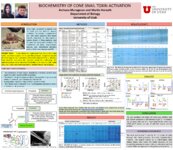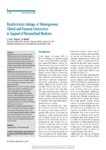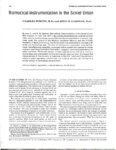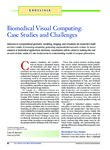TO
| Creator | Title | Description | Subject | Date | ||
|---|---|---|---|---|---|---|
| 801 |
 | Olivera, Baldomero M. | Biochemical characterization of ?M-RIIIJ, a Kv1.2 channel blocker: evaluation of cardioprotective effects of ?M-conotoxins | Conus snail (Conus) venoms are a valuable source of pharmacologically active compounds; some of the peptide toxin families from the snail venoms are known to interact with potassium channels. We report the purification, synthesis, and characterization of ?M-conotoxin RIIIJ from the venom of a fish-... | 2010 | |
| 802 |
 | Bernstein, Paul S. | Biochemical characterization of the retinoid isomerase system of the eye | We have previously shown that membranes from the retinal pigment epithelium can transform added all-trans-retinol into a mixture of 11-cis-retinoids, demonstrating the "missing reaction" in the visual cycle for the first time (Bernstein, P. S., Law, W. C., and Rando, R. R. (1987) Proc. Natl. Acad. S... | Hydrogen-Ion Concentration | 1987 |
| 803 |
 | O'Rourke, Dennis H. | Biochemical heterozygosity and morphologic variation in a colony of papio hamadryas hamadryas baboons | This analysis examines the association between genetic heterozygosity and individual morphologic variation in a captive population of Papio hamadryas hamadryas consisting of 403 juveniles and adults. The population structure of the colony was artificially generated and maintained and is thus rigoro... | Population genetics; Polygenic; Inbreeding | 1994 |
| 804 |
 | Olivera, Baldomero M. | Biochemical studies of ω-conotoxin GVIA; a peptide toxin inhibiting voltage-sensitive Ca++ channels | The fish-hunting cone snails use their venom to quickly paralyze their more agile prey. In the last few years, our laboratories have carried out a program of analyzing biologically active components present in the fish-hunting cone snail venoms (Cruz et al. 1985; Olivera et al. 1985). We have concen... | Conotoxins; Calcium channels; Conus geographus; Venom | 1987 |
| 805 |
 | Horvath, Martin P. | Biochemistry of Cone Snail toxin activation | Cone snails use venom to capture prey for food and for defense against predators. The venom is composed of over 100 active peptides that target specific receptors in the nervous system. Several of these peptides have the potential to become medicine for treatment of pain, depression, seizures, and n... | biochemistry; horvath; olivera; cone snail; toxin; nmda; elution; buffers; sparse matrix test; protease; protein; purification; neurotoxin; conotoxin | 2013 |
| 806 |
 | Reitze, Arnold W. | BiofuelsSnake Oil for the Twenty-First Century | Congress should slash its subsidies for corn-based ethanol and focus its efforts on research and development efforts to advance the technologies needed to reduce our need for foreign petroleum. We should be working to lower the costs of cellulosic ethanol production as well as working on promisi... | 2008-12-01 | |
| 807 |
 | Mitchell, Joyce A. | Bioinformatics linkage of heterogeneous clinical and genomic information in support of personalized medicine | Objectives: Biomedical Informatics as a whole faces a difficult epistemological task, since there is no foundation to explain the complexities of modeling clinical medicine and the many relationships between genotype, phenotype, and environment. This paper discusses current efforts to investigate su... | 2007-01-01 | |
| 808 |
 | Seger, Jon; Davidson, Diane W. | Biological richness of deserts | A desert is "waterless," "treeless," "barren," "remote," "uninteresting," and "presumably uninhabited," according to the authoritative Oxford English Dictionary. The word is derived from deserere, a Latin verb meaning "to leave." In English, to desert is still to "abandon," "forsake," or "fail." Bec... | Desert life; Desert biodiversity | 1995 |
| 809 |
 | Gardner, Reed M. | Biological Signals and Small Voltages (Letter) | Biomedical Informatics | 1994 | |
| 810 |
 | Harrison, Reid R. | Biologically inspired analog IC for visual collision detection | We have designed and tested a single-chip analog VLSI sensor that detects imminent collisions by measuring radially expanding optic flow. The design of the chip is based on a model proposed to explain leg-extension behavior in flies during landing approaches. We evaluated a detailed version of thi... | Visual collision detection; VLSI | 2005-11 |
| 811 |
 | Clayton, Dale H. | Biology, ecology, and evolution of chewing lice | Chewing lice are small, dorsoventrally compressed insects and are parasites of virtually all birds (Fig. 1) and some mammals (Fig. 2). Many chewing lice are host specific, being found on only a single species of host. All chewing lice are permanent ectoparasites and complete their entire life c... | Chewing lice | 2003 |
| 812 |
 | Pershing, David W. | Biomass combustion: relationship between pollutant formation and fuel composition | A 65-kW refractory-walled reactor was used to study biomass combustion under conditions typical of the suspension-burning phase in a spreader-stoker-fired boiler. Isothermal combustion data and nitric oxide (NO) emission rates were obtained as a function of temperature, local oxygen concentration, ... | Combustion; Emissions; Energy; Environmental control; Fuels; Pyrolysis; Biomass fuel; Particulates | 1989 |
| 813 |
 | Burton, Charles | Biomedical Instrumentation in the Soviet Union | Biomedical Informatics | 1977 | |
| 814 |
 | Furse, Cynthia M. | Biomedical telemetry: today's opportunities and challenges | Biomedical telemetry is used today to communication with cardiac devices, insulin pumps, and a few other implantable devices that are on the order of 1-2" in diameter. Future systems promise advanced communication with cardiac, optical, neurological and auditory devices that are on the order of a ce... | 2009-03 | |
| 815 |
 | Johnson, Christopher R. | Biomedical visual computing: case studies and challenges | Advances in computational geometric modeling, imaging, and simulation let researchers build and test models of increasing complexity, generating unprecedented amounts of data. As recent research in biomedical applications illustrates, visualization will be critical in making this vast amount of data... | 2012-01-01 | |
| 816 |
 | Christensen, Douglas A. | Biosensor development at the University of Utah | Interest in biosensors has increased rapidly in the past few years due to the many potential advantages of these devices, such as small size, speed of response, and specificity 111. The term "biosensor" in the broad sense describes any device or apparatus which detects biological signals for the pu... | Silicon retina; Photosensing array; CHEMFET; Fluorescence lmmunosensor; Planar waveguide | 1994-07 |
| 817 |
 | Sekercioglu, Cagan | Birding economics: conservation through commodification | In the long-run, the quality of our birding (and the length of our lists) depends on our success in conserving birds and their habitats. Who would not love to see a Labrador Duck during a pelagic trip, have Carolina Parakeets fly overhead on a CBC, or photograph a Bachman's Warbler foraging in a can... | 2003-01-01 | |
| 818 |
 | Behle, William H. | Birds of pine valley mountain region, Southwestern Utah | It has long been a practice among ornithologists to study the distribution, variation, and ecological relationships of birds in areas characterized by diverse physiographic features. Such studies are motivated usually by the desire to aid in finding solutions for the many problems concerning the dis... | 1943-08-10 | |
| 819 |
 | Behle, William H. | The birds of Southeastern Utah | Southeastern Utah is a rugged and colorful portion of the state. As a part of the Colorado Plateau Physiographic Province it is characterized by an arid climate, multicolored but mostly red sandstones, shales and limestones, weathered sand deep box canyons, and high, isolated, lacolithic mountain ra... | 1960-10 | |
| 820 |
 | Behle, William H. | The birds of the deep Creek Mountains of Central Western Utah | In furtherance of a long-time survey of the avifauna of Utah the Deep Creek Mountain region of the central western part of the state was chosen as an area for intensive study. It was expected that gradients would occur in the characters of geographically variable birds between populations from the i... | 1955-01-10 | |
| 821 |
 | Behle, William H.; Bushman, John B.; Greenhalgh, Clifton M. | Birds of the Kanab area and adjacent high plateaus of Southern Utah | The gateway to central southern Utah is the town of Kanab, located in Kane County just a few miles north of the Utah-Arizona line. At an elevation of 4973 feet it nestles in an indenture in the Vermillion Cliffs where Kanab Canyon emerges. North of these Vermillion Cliffs, rising like two additional... | 1958-10-01 | |
| 822 |
 | Woodbury, Angus M. | Birds of the Navajo Country | The Navajo country as covered in this paper lies in southeastern Utah and northeastern Arizona and is bounded on the north, west and south by the San Juan, Colorado, Little Colorado and Rio Puerco rivers and on the east by the Arizona-New Mexico state line. That part of the Navajo country lying in n... | 1945-03-01 | |
| 823 |
 | Behle, William H. | The birds of the Raft River Mountains, Northwestern Utah | As another facet in a long-term analysis of the birds of Utah, an avifaunal survey was made in the northwestern corner of the state. Here the principal physiographic feature is the Raft River Mountains. The main axis of this range runs in an east-west direction paralleling the Utah-Idaho border imme... | 1958-05-10 | |
| 824 |
 | Narus, Scott P. | Birth of identity: Understanding changes to birth certificates and their value for identity resolution | Introduction Identity information is often used to link records within or among information systems in public health and clinical settings. The quality and stability of birth certificate identifiers impacts both the success of linkage efforts and the value of birth certificate registries for identit... | 2014-01-01 | |
| 825 |
 | Miller, Jan D. | Bismuth dissolution from smelter flue dust residues | Effective bismuth removal from flue dust residues has been accomplished for flue dusts from both zinc and copper smelters. Selective dissolution of bismuth, with respect to silver and lead, can be achieved by the proper manipulation of temperature, sulfuric acid addition and sodium chloride addition... | technique; distribution; chloride | 1976 |
